Artificial Intelligence (AI) has brought about a significant transformation in the software industry and its technologies, revolutionizing the business landscape. Chatbots are one of the types of AI-powered platforms that mimic human-like conversation. Among these platforms, ChatGPT is a powerful tool that has quickly gained popularity on the internet, attracting millions of users within just a few days since its launch.
If you’re intrigued by the idea of conversing with a chatbot, then ChatGPT is definitely worth checking out. This AI-powered platform is capable of processing both written and spoken language and providing human-like responses, which means you can have real conversations with the application that help solve your daily problems quickly and efficiently. However, there’s much more to ChatGPT than meets the eye. To fully understand its capabilities, including its features, functions, pricing, and more, it’s important to delve into the details.
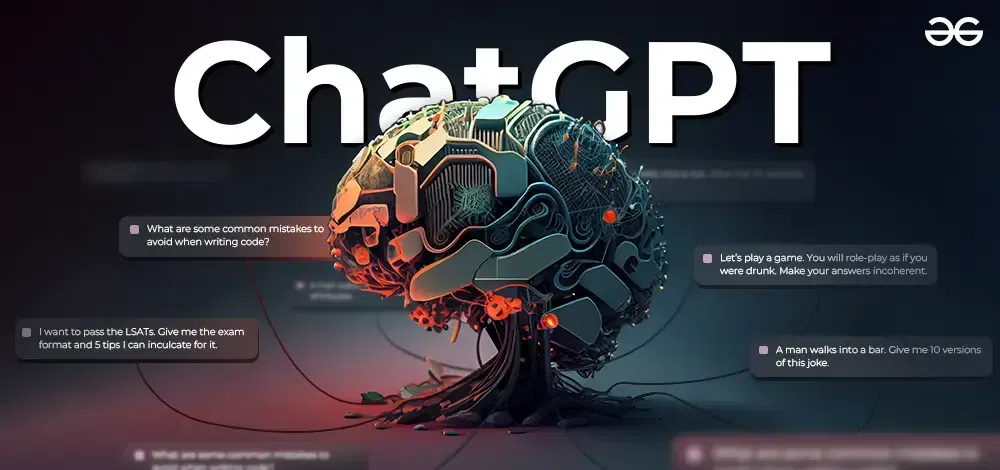
This article aims to provide you with a comprehensive overview of ChatGPT so that you can gain all the information you need.
Table of Contents
- What is ChatGPT?
- How to Access ChatGPT For Free?
- Working of ChatGPT-Insight in its Training
- ChatGPT Features
- To What Extent Is ChatGPT Considered Significant?
- Limitations of ChatGPT
- ChatGPT Troubleshooting
- Difference Between ChatGPT and GPT-4
- ChatGPT vs. Other AI Chatbots
- Can ChatGPT Outperform Google?
- Industries using ChatGPT: What is ChatGPT used for?
- How to Make Money Using ChatGPT?
- How to use ChatGPT to Pass Benchmark Exams?
- ChatGPT and Tech Industry
- Is it Possible to Detect ChatGPT Content?
- ChatGPT Pricing & Support
- Is ChatGPT a Friend or Foe?
What is ChatGPT?
ChatGPT is an AI chatbot or you can say NLP(Natural Language Processing) tool developed by OpenAI that allows a natural conversation between humans and a bot. Here GPT stands for Generative Pre-Trained Transformer which is a type of large language model for its training. This can make answers to your questions which might be related to social media posts, content writing, coding, emails, and a lot more.
Who Made ChatGPT?
ChatGPT was created by OpenAI, an organization dedicated to an artificial intelligence research lab in San Francisco. Its co-founders are Elon Musk, Sam Altman, Peter Thiel, OpenAI chief scientist Ilya Sutskever, Jessica Livingston, and Linkedin co-founder Reid Hoffman. They officially released ChatGPT on November 30, 2022. Currently, Sam Altman is the CEO of ChatGPT.
If you want to learn more about what is ChatGPT and everything around it, just read along.
How to Access ChatGPT For Free?
Accessing the ChatGPT website is a straightforward process. Here are a few common ways to access and interact with ChatGPT free:
- OpenAI Playground: The OpenAI Playground is an online platform where you can directly access ChatGPT. Simply open ChatGPT, log in with your OpenAI account from the ChatGPT Login Screen and navigate to the Playground, and you’ll be able to type in prompts and receive responses from the model.
- Integrations: ChatGPT is integrated into various applications and platforms. Some online services, chatbots, or virtual assistants may incorporate ChatGPT’s capabilities, allowing you to access the model through those specific interfaces.
- OpenAI API: OpenAI provides an API for developers to access and integrate ChatGPT’s functionality into their applications, products, or services. The API documentation details how to make API requests and receive responses from the model programmatically.
- Partner Applications: OpenAI has partnered with third-party applications and platforms, which may offer access to ChatGPT’s features. These applications can provide customized interfaces or specialized functionalities built on the model.
Don’t Forget to Explore – How to Use ChatGPT-4 For FREE?
Working of ChatGPT-Insight in its Training
The working of ChatGPT seems easy, but it is more complex than you can imagine. The model utilizes a transformer architecture, a deep learning model designed explicitly for processing sequential data. The model was trained in two phases- pre-training and fine-tuning. In pre-training, ChatGPT was exposed to a large dataset of text from different sources like books, web text, articles, and other sources from the internet. It was trained with approximately 570 GB of data with more than 300 million words.
In the fine-tuning phase, ChatGPT was trained on a more specific dataset with the aid of a human reviewer based on the review guidelines provided by OpenAI. Such a process has allowed ChatGPT’s function per specific criteria, like avoiding biased and inappropriate content. Let us see how ChatGPT was trained to have human-like chatting.
Chatting with ChatGPT
ChatGPT’s training process enables it to interact with humans. Here’s a simplified explanation of how it works:
ChatGPT starts by learning from a massive amount of text found on the internet. It studies the patterns, grammar, and factual information in human language. To make ChatGPT capable of chatting, a dataset is created with sample dialogues. These dialogues simulate conversations between a user and an AI assistant. The dataset is carefully designed to cover various topics and possible user inputs.
Human AI trainers engage in conversations, taking turns playing the user and the AI assistant. The trainers aim to generate helpful and contextually appropriate responses. They have access to suggested answers generated by the model but are not limited to using them.
The collected dialogues are mixed with the existing dataset and used to fine-tune ChatGPT. This fine-tuning process involves reinforcing the model’s ability to generate responses. The trainers rank and select the most suitable and informative responses as part of the training.
OpenAI maintains an ongoing relationship with the trainers. They provide feedback, ask questions, and seek clarifications to improve the model’s performance. OpenAI uses this feedback to make the necessary adjustments and enhancements to the model over time.
Through this training process, ChatGPT learns to engage in interactive conversations and generate responses based on the input it receives from users.
ChatGPT Features
You must know that ChatGPT is in the news for its excellent features. Its several features make it a powerful language model for interactive conversations. Here are some key features:
- ChatGPT is designed to have dynamic and engaging user conversations. You can chat with it just like you would talk with another person, exchanging messages back and forth.
- ChatGPT has been trained on a wide range of text, allowing it to understand and generate responses that sound natural and human-like.
- It understands the context of the conversation, which means it considers the previous messages and uses that information to provide relevant and coherent responses.
- ChatGPT has access to a wealth of information due to its extensive training. You can get answers and insights on various topics you ask with ChatGPT.
- The model has a good grasp of grammar and sentence structure and can understand the meaning behind your messages. This helps it generate responses that make sense.
- You can ask ChatGPT open-ended questions, and it will do its best to provide informative and helpful answers based on what it has learned during training.
- ChatGPT can offer assistance, suggestions, and recommendations on various subjects. It leverages its knowledge to provide useful information or guide you in the right direction.
- If you need to communicate in different languages, ChatGPT can translate text from one language to another, helping bridge language barriers.
- ChatGPT can also generate creative and imaginative text. If you want to explore storytelling or fictional narratives, you can prompt it, and it will generate engaging content in one go.
- OpenAI actively collects user feedback to enhance and refine ChatGPT continuously. This ongoing process helps address limitations and make the model more reliable and useful.
ChatGPT – Use Case
Use Case 1: Using ChatGPT for job application assistance.
ChatGPT can be used to provide job application assistance. Here’s how it could be helpful:
- Resume/Cover Letter Review: ChatGPT can analyze and provide feedback on resumes and cover letters. You can get suggestions for improvement, highlight areas that need attention, and provide general guidance on crafting effective job application documents.

- Interview Preparation: ChatGPT can simulate interview scenarios and provide practice sessions. It can ask interview-style questions, evaluate responses, and offer constructive feedback to help you to prepare for job interviews.
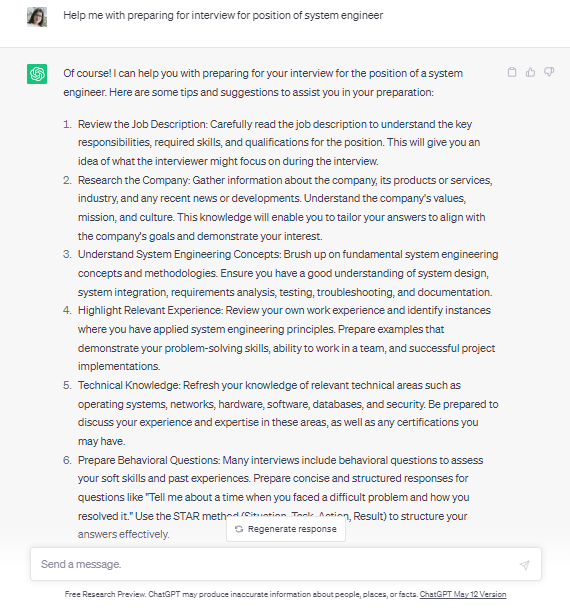
- Job Search Guidance: ChatGPT can assist with job search strategies by providing tips, recommending relevant job boards or websites, and suggesting keywords or industry-specific terms to optimize search results.
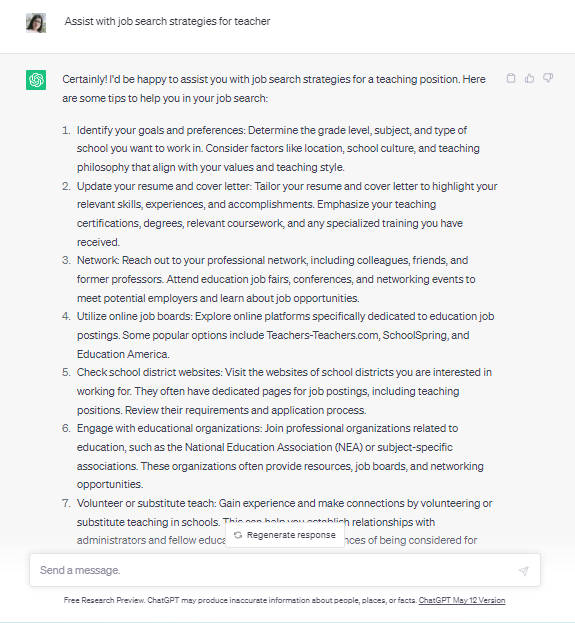
- Career Advice: You can seek general career advice from ChatGPT, such as exploring different career paths, discussing professional development opportunities, or receiving insights on industry trends.
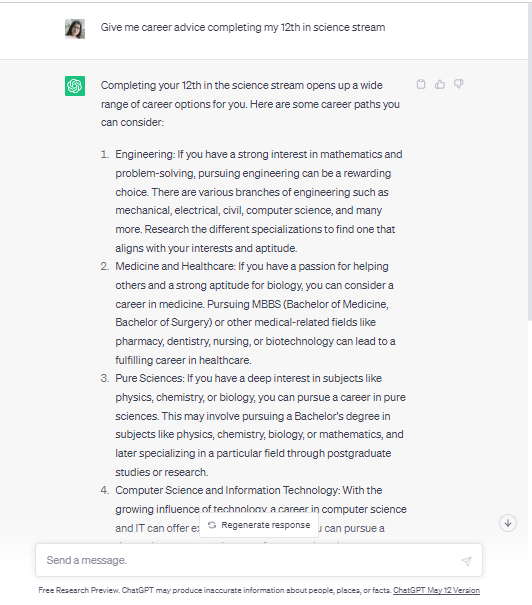
Use Case 2: ChatGPT’s Expansion to Social Media
Expanding ChatGPT’s functionality to social media platforms can offer various benefits. Some of those are explained below:
- Personal Assistant: ChatGPT can act as a personal assistant, helping you to manage your social media accounts. It can schedule posts, provide content suggestions, and engage with followers by generating replies or comments.
- Content Generation: ChatGPT can assist content creators by generating ideas, suggesting topics, or inspiring social media posts, blog articles, or YouTube videos.
- Community Engagement: ChatGPT can engage in conversations with you on social media platforms, answering questions, providing information, and offering recommendations based on its trained knowledge.
- Language Support: ChatGPT’s language translation capability can be leveraged to facilitate communication between users of different languages on social media platforms, fostering global connections and understanding.
To what extent is ChatGPT considered significant?
In the realm of natural language processing and artificial intelligence, ChatGPT is a cutting-edge language model built on the GPT-3.5 architecture. Its importance cannot be overstated, as it represents a major advancement in language models and showcases the impressive capabilities of deep learning models on a large scale.
- ChatGPT can comprehend complex language structures, provide coherent and contextually relevant answers, and engage in interactive conversations with users.
- ChatGPT’s versatility makes it valuable across a wide range of applications. It can assist with tasks such as answering questions, providing recommendations, offering explanations, and engaging in creative text generation.
- The availability of ChatGPT as an AI language model makes advanced language processing capabilities accessible to a broader audience. You can interact with the model through user-friendly interfaces, making it easier to harness its potential without extensive technical expertise.
- ChatGPT is continuously learning and improving. OpenAI actively collects user feedback and iteratively updates the model to address limitations, reduce biases, enhance response quality, and improve its overall performance. This commitment to ongoing development ensures that ChatGPT evolves and remains relevant.
- The deployment of ChatGPT has sparked public interest and engagement. It has prompted discussions about AI ethics, responsible use of technology, and the potential impact of AI models on society. OpenAI’s transparency in sharing information about the model’s limitations and training process has fostered a broader dialogue on the responsible deployment of AI systems.
- ChatGPT’s capabilities have inspired researchers, developers, and organizations to explore and innovate further in natural language processing. It has sparked new ideas, techniques, and advancements in language models, pushing the boundaries of what is possible in human-AI interaction.
- When we push ChatGPT to its limits, we learn more about its strengths. It has passed the Nazi Test, which measures the functionality of a chatbot and checks how it can resist being fooled into thinking and communicating with humans who are trying to lead it astray.
Limitations of ChatGPT
ChatGPT, like any other AI language model, has several limitations that are important to consider:
- Lack of Real-Time Information: ChatGPT does not have access to real-time information. It’s trained on a snapshot of the internet up until September 2021. As a result, it may not be aware of the latest news, events, or developments after its training cutoff date.
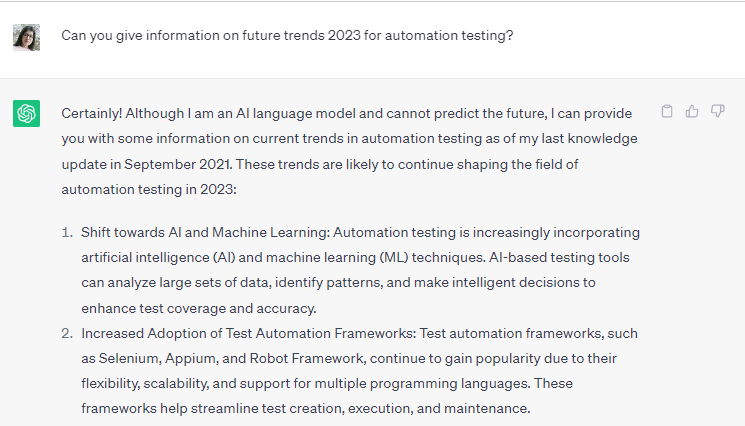
- Sensitivity to Input Phrasing: ChatGPT is sensitive to how you phrase their prompts. Even a slight rephrasing of a question can yield different responses. This means that the model’s answers may vary depending on how the question is framed, which can sometimes result in inconsistent or unexpected responses.
- The propensity for Errors and Inaccuracies: ChatGPT can generate plausible-sounding but incorrect or nonsensical responses. It may occasionally provide information that is inaccurate, incomplete, or out of context. Therefore, it’s important to verify information from reliable sources.
- Lack of Contextual Understanding: While ChatGPT attempts to understand context, it may still struggle to maintain a consistent context over a series of messages. It may sometimes provide responses that are not directly related to the previous message or fail to grasp nuanced conversations.
- Biases and Inappropriate Responses: ChatGPT can inadvertently exhibit biases present in the training data. It may produce responses that reflect societal biases, controversial viewpoints, or offensive content. OpenAI has tried to reduce biases, but it may not be eliminated.
- Over-Reliance on Suggested Prompts: ChatGPT provides suggested user prompts to guide the conversation. While these suggestions are meant to be helpful, users may feel compelled to choose from them even if they don’t fully align with their intended message. This can result in less personalized or accurate interactions.
- Ethical Considerations: The use of ChatGPT raises ethical concerns. It is important to ensure responsible use, respect user privacy, and address potential misuse, such as malicious content generation, social engineering, or spreading misinformation.
ChatGPT Troubleshooting
When encountering issues or troubleshooting with ChatGPT, there are a few steps you can take to address the problem.
- Check your Internet connection to ensure a stable connection is established. If using the OpenAI Playground, refreshing the page or clearing your browser cache might resolve any temporary glitches.
- If the issue persists, try rephrasing your prompts or providing more specific instructions to obtain the desired response. It’s also important to know ChatGPT’s limitations and the potential for inaccurate or nonsensical answers.
- If you believe there is a technical problem or have feedback regarding the model’s performance, contact OpenAI’s support channels or community forums for assistance.
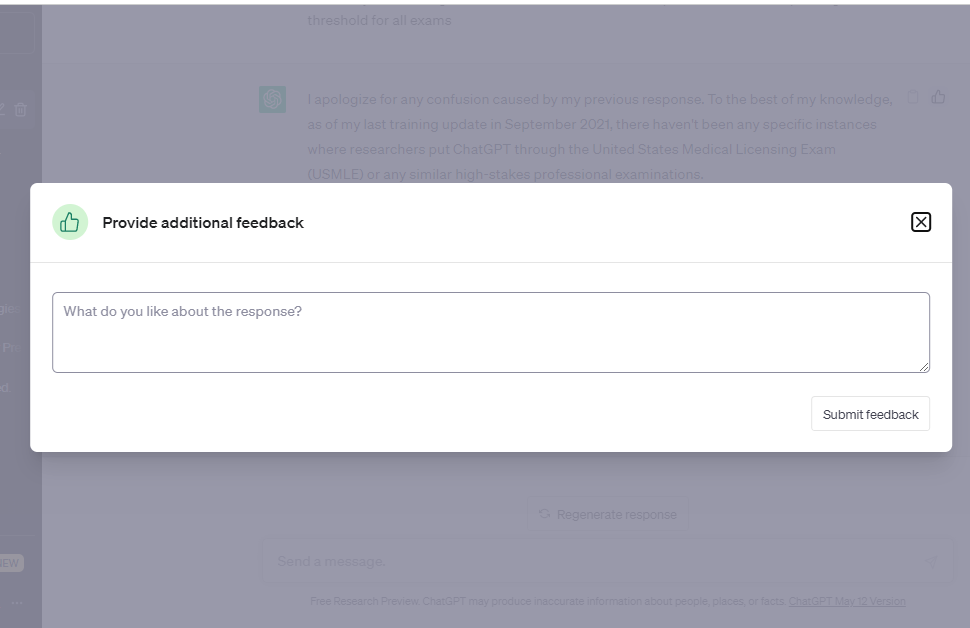
- Remember that ChatGPT is continuously evolving, and OpenAI actively collects user feedback to improve its functionality, so reporting any issues you encounter can contribute to future enhancements.
Difference Between ChatGPT and GPT-4
ChatGPT and GPT-4 are both built by OpenAI, but they hold some key differences. Chat GPT-4 is the latest version of language model systems, and it brings a lot of exciting advancements compared to its predecessor, GPT-3.5, which is the version currently powering ChatGPT. One of the notable upgrades in ChatGPT-4 is its ability to handle both text and images as inputs and generate text-based outputs. This is useful when analyzing and making sense of things like worksheets, graphs, or charts.
Right now, GPT-4’s image input feature is not available to the general public. However, you can access its text input capabilities by subscribing to ChatGPT Plus, which costs $20 per month. Another option is to use Bing Chat, a chatbot developed by Microsoft that runs on GPT-4. Bing Chat is free to use, but you might have to join a waitlist before you can start using it.
GPT-4 has a maximum token limit of 32,000 (25000 words), significantly increasing from GPY-3.5’s 4000 tokens (3125 words). Further, GPT-4 is more advanced in generating human-like text with extended ability, different dialects, and the capability to express emotion in text. It can answer complex questions by generating information from different sources, but ChatGPT struggles to connect the dots.
Let’s summarise the above in table form for your easy understanding.
| Feature | ChatGPT | GPT-4 |
|---|---|---|
| Developer | OpenAI | OpenAI |
| Latest Version | GPT-3.5 | GPT-4 |
| Ability to handle text and image inputs | No | Yes |
| Text-based outputs | Yes | Yes |
| Image input availability | Not available to the general public | Not available to the general public |
| Text input availability (via subscription) | ChatGPT Plus subscription ($20 per month) | Yes |
| Image input availability (via Bing Chat) | N/A | Available (join the waitlist for access) |
| Maximum token limit | 4,000 tokens (3,125 words) | 32,000 tokens (25,000 words) |
| Text generation capabilities | Limited | More advanced with extended ability, different dialects, and emotion expression in the text |
| Ability to answer complex questions | Struggles to connect the dots | Can generate information from different sources to answer complex questions |
ChatGPT vs. Other AI Chatbots
Bing Chat comparison with ChatGPT
ChatGPT is mainly being compared with the two AI-driven chatbot:-Bings and Bard, for their functionalities and capabilities. The new version of Bing released in early February can integrate with ChatGPT, and Bing Chat is powered by the next-generation version of Open AI’s language model. It was later revealed that Bing Chat had been running on GPT-4, the most advanced OpenAI model, even before its official launch.
Unlike the standard ChatGPT, Bing Chat has a couple of advantages. Firstly, it can access current information since it’s connected to the internet. Additionally, Bing Chat references the sources it pulls information from, which helps verify the information and reduces the chances of misinformation. In contrast, ChatGPT’s knowledge is limited to before 2021.
Google Bard comparison with ChatGPT
Bard is Google’s AI chat service, introduced on February 6 as an experimental project. It aims to compete with ChatGPT in the field of AI chatbots. Google gradually rolled out access to Bard through a waitlist.
Unlike ChatGPT, Google Bard utilizes a lightweight version of Google’s Language Model for Dialogue Applications (LaMDA). It has the advantage of internet access, allowing it to gather information from the web for its responses. However, Bard encountered some difficulties during its launch. In a demo, it provided inaccurate information about the James Webb Space Telescope (JWST). Google recognized the need for a more rigorous testing process and initiated a Trusted Tester program to address these issues.
When comparing Bard to ChatGPT, it appears that ChatGPT outperforms Bard in terms of capabilities. Despite having internet access, Bard often fails to provide accurate answers. For example, it struggles to answer questions about all US Presidents, often acknowledging its limitations as a language model instead. Bard also faces challenges when responding to coding and maths-related queries.
Can ChatGPT Outperform Google?
Interacting with a computer and receiving answers from it can be quite helpful, and ChatGPT excels at providing such responses. In comparison, when using Google, you get links to relevant websites and recommendations from Google itself. However, it’s worth noting that ChatGPT often offers superior solutions compared to Google’s suggestions, making it seem like a direct competitor.
Nevertheless, it’s important to exercise caution before fully relying on ChatGPT or any other information source. Just like with Google and Wikipedia, verifying information from reliable sources is always wise to ensure accuracy.
Confirming the accuracy of ChatGPT’s answers requires some effort since it provides raw text without any supporting links or citations. Despite this limitation, it can still be beneficial and even provoke thought on certain occasions. Although ChatGPT might not be directly visible in Google search results, Google has already harnessed the power of AI and created its own impressive language models.
While ChatGPT is proficient at providing answers, it’s crucial to fact-check and verify information from trustworthy sources. ChatGPT and Google have their strengths and limitations, and utilizing a combination of reliable sources can lead to more accurate and comprehensive knowledge.
ChatGPT vs. Other Search Engines
ChatGPT is designed to generate human-like text responses and engage in interactive conversations, providing information, explanations, and opinions. On the other hand, search engines aim to retrieve web content based on user queries, offering a broader scope of information from the Internet.
While ChatGPT’s knowledge is based on training data with a cutoff date, search engines can access the most up-to-date information available online. ChatGPT provides interactive and conversational responses, understanding context and generating detailed explanations, while search engines deliver concise and objective information without engaging in conversation.
ChatGPT is useful for interactive scenarios, creative writing, tutoring, and entertainment purposes. Search engines are primarily used for finding specific information, researching topics, gathering data, and discovering relevant resources.
Industries using ChatGPT: What is ChatGPT used for?
ChatGPT, with its advanced natural language processing capabilities, has found applications in various industries. Let’s explore some industries that are utilizing ChatGPT:
- Customer Support: Many companies are using ChatGPT to provide automated customer support through chatbots. It helps customers by answering frequently asked questions, providing information about products or services, and assisting with common issues.
- Content Creation: ChatGPT is proving to be a valuable tool in content generation. It assists content creators in writing blog posts, articles, social media captions, and more. It can generate ideas, expand on topics, and contribute to the overall writing process.
- Education: ChatGPT is finding its place in the education sector as a virtual tutor. It helps students by answering their questions, explaining concepts, and providing assistance with homework. Language learning is another area where ChatGPT offers support, providing practice exercises and stimulating conversations.
- Research and Knowledge Discovery: Researchers and academics utilize ChatGPT to aid their work. ChatGPT’s ability to provide explanations and contextual information is valuable for knowledge discovery. It can summarise research papers, generate hypotheses, and assist with literature reviews.
- Creative Writing and Storytelling: Writers, authors, and storytellers are embracing ChatGPT as a tool to boost their creativity. It can help generate story ideas, develop characters, and provide engaging dialogue. By simulating human-like conversations, ChatGPT enhances the storytelling process.
How to Make Money Using ChatGPT?
There are many different ways to make money using ChatGPT. You can leverage the ChatGPT for free and earn even if you have a limited understanding of its ability. For example, you can ask ChatGPT about diverse business ideas in any domain. Here is an example of a business idea that gives excellent suggestions and can be further discussed to structure a plan for getting started.
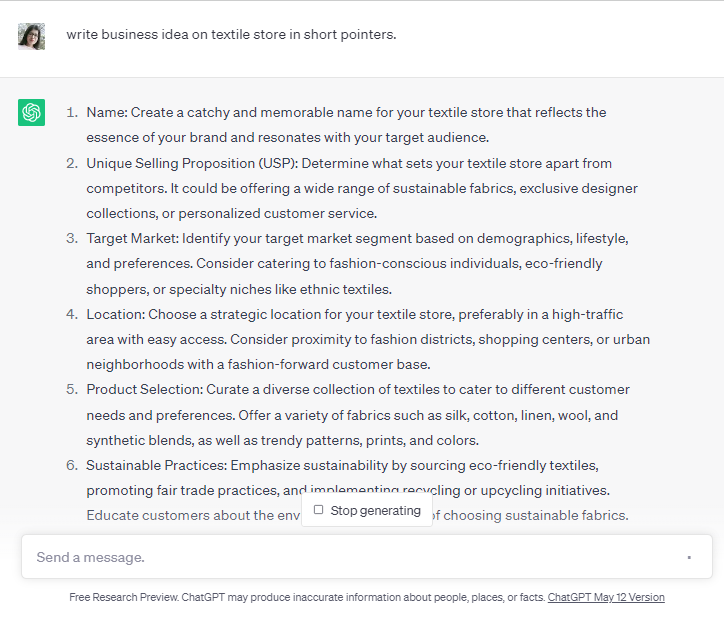
You can offer your ChatGPT-powered services as a freelancer, which can be taken to the next level. It helps you generate high-quality content and give valuable service to the clients. Such content is needed for email marketing, social media management, etc.
You can also write a blog using ChatGPT, build an audience, and monetize it with advertising and sponsored content. Having well-crafted email content and creating compelling email-marketing campaigns with ChatGPT is also possible.
You can use ChatGPT to generate YouTube video scripts and gain ideas for videos. This will help you generate engaging videos, gain ad revenue and sponsorships and increase traffic to your service or products. In addition, you can write your books using ChatGPT in just a few minutes and get them self-published on Amazon Kindle.
Also Read: 10 Ways to Make Money with ChatGPT
Exams that ChatGPT Managed to Crack Easily
ChatGPT has demonstrated impressive capabilities in passing benchmark exams. Its ability to answer questions and provide coherent responses showcases its understanding of a wide range of topics.
ChatGPT was put through the United States Medical Licensing Exam and it was found that ChatGPT performance was near the passing threshold of all exams. Further, Big Think, a science journalism and executive editor Alex Berezow asked 10 questions on microbiology, and surprisingly, ChatGPT answered all questions accurately. It has also passed law exams in four courses at the University of Minnesota and the University of Pennsylvania’s Wharton School of Business.
However, it’s important to note that ChatGPT’s performance on these exams doesn’t necessarily imply a comprehensive understanding or knowledge base. While it can generate impressive responses, it may still lack the ability to verify facts or provide accurate information in every instance.
Therefore, while ChatGPT’s performance in passing benchmark exams is promising, it’s essential to approach its responses critically and cross-verify information from reliable sources for complete accuracy.
ChatGPT and Tech Industry
The role of ChatGPT is broader than just writing, composing music, or writing emails. It’s extensively used in the tech industry and has gained popularity from day one since its launch. Let’s talk about the impact of ChatGPT on the tech industry, particularly in the automation of software testing, software development, coding, and web development.
In the automation testing of software applications, ChatGPT is brought into the picture, which accelerates the speed of the test process. But how can this be done? ChatGPT is not an automation testing tool; you can use this in test case generation, test data generation, test script automation, test result analysis, and generating test reports.
The developers are using ChatGPT to generate code snippets, getting suggestions and guidance in software application development. Regarding coding, ChatGPT can write code, detect its accuracy, and offer insight into various programming languages and best practices. Hence, it solves any coding challenges in less time.
But ChatGPT is not a substitute for human expertise. While it gives suggestions and generates code, developers must evaluate and test the output to ensure its efficiency.
Is it possible to detect ChatGPT content?
Yes, detection of ChatGPT content is possible if you focus on certain factors. Although it can write convincingly and give a direct answer to your question, it is not important that what it says is always true. If you look at its way of answering, you will note that asking the same question will generate a similar type of response. There is lots of repetition of information which the human can easily notice.
Further, if you look at its politeness within the text, which is a specific ChatGPT writing style, you can also detect ChatGPT-generated writing. There are other tools that educators widely use and the content industry to detect AI content. Read the below information.
Existence of a Tool That Recognizes ChatGPT Text
AI detector tools can detect AI text but are not 100% reliable. However, due to the concern regarding cheating done by students or writers copying the AI content to write blogs or articles, the need for ChatGPT text detectors is required. A tool like Open AI’s classifier can detect 26% of AI written text, however, it can also give false positives 9% of the time. Other tools like CopyLeak, Writer AI Content Detector, and GPT-2 Output Detector. Similarly, another tool like Turnitin detects ChatGPT contents. It works by comparing a piece of work to a database of previously submitted material and also searches the internet for potential instances of plagiarism. When you submit your work to Turnitin, it checks if there are any similarities with other documents that have been previously uploaded. It also scans the internet to see if any parts of your work match content found online.
Although they can accurately detect AI content, but they are insufficient to detect ChatGPT-generated writing.
ChatGPT Pricing & Support
ChatGPT offers a fantastic feature – it’s completely free to use! Regardless of whether you’re writing, coding, or engaging in various other activities, you can access ChatGPT without any cost. It’s a valuable resource that provides users with exceptional capabilities and assistance. However, if you’re looking for extra perks and benefits, a subscription option is available, with a ChatGPT cost of $20 per month.
By subscribing, you gain advantages like guaranteed access even during peak times and faster response times. Another notable benefit is that subscribers get access to the latest version of the AI, GPT-4. So, while the free version is fantastic, the subscription model provides additional advantages for those who want a little more.
Is ChatGPT a Friend or Foe?
When it comes to ChatGPT, opinions vary on whether it’s a friend or foe thing. On the one hand, it offers convenience and assistance in various tasks, like writing emails or finding information online. It can save us time and effort. However, some concerns need to be addressed. For instance, ensuring accuracy and preventing the spread of misinformation is crucial. It’s essential to fine-tune and train AI models properly to improve performance.
But does this mean that AI is taking over the world? Well, not yet, perhaps, but according to Sam Altman, the CEO of OpenAI, human-style intelligence in AI is not too far off. Altman agrees with Elon Musk’s concerns about the risks of dangerously strong AI, particularly cybersecurity. He even mentioned the possibility of achieving real AGI (Artificial General Intelligence) within the next decade, urging us to take the associated risks seriously.
Another interesting aspect Altman highlighted is the ongoing debate about the behavior of powerful AI systems. Should they align with user preferences or the intentions of their creators? This question raises important considerations about the values and ethics embedded in these systems—a debate that will undoubtedly shape our society’s future.
So, answering whether ChatGPT is a friend or foe, it’s a complex matter with various perspectives. It offers benefits, but we must address its challenges and have important discussions about the impact and values associated with AI technology.




